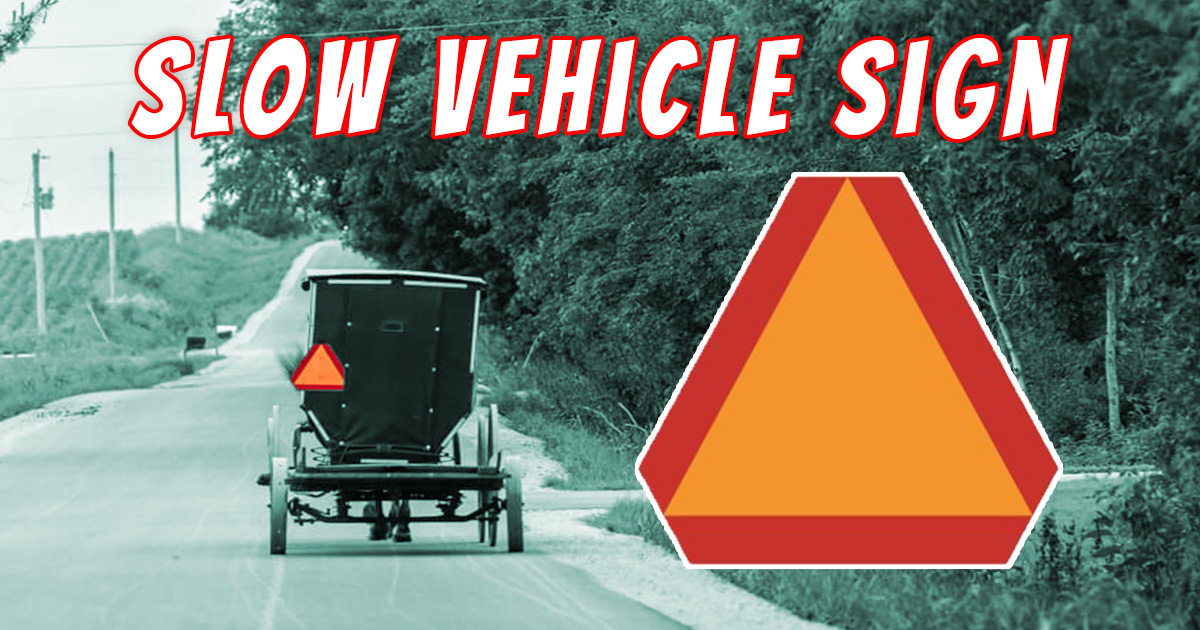Introduction
When driving on public roads, especially in rural or construction-heavy areas, you might encounter vehicles moving significantly slower than the regular traffic. These slow-moving vehicles are often equipped with a slow vehicle sign, a crucial safety measure designed to alert faster drivers to their presence.. Whether you’re operating farm equipment, a construction vehicle, or any other slow-moving machine, knowing the importance and proper use of these indicators is vital for safety on the roads. This guide will explain what a slow-moving vehicle sign is, when and where it’s required, the legal regulations involved, and its benefits.
Meaning and Purpose of a Slow Vehicle Sign
A slow vehicle sign is a distinctive, reflective orange triangle bordered with red, specifically designed to warn other drivers of a slow-moving vehicle ahead. This sign is a safety measure required for vehicles that travel at speeds less than 25 mph (40 km/h). Typically seen on farm equipment, tractors, construction vehicles, and even horse-drawn carriages, the purpose of the slow vehicle sign is to reduce accidents by informing faster-moving vehicles that they need to slow down.
The triangle’s reflective material ensures high visibility during both day and night. Its bright orange center and red border make it easy for other road users to recognize, allowing them to adjust their speed and overtake safely when necessary.
When and Where Are Slow Vehicle Signs Required?
Usage on Public Roads
These safety signs are mandatory on public roads for slow-moving vehicles. For example, tractors, construction machines, and other vehicles operating at low speeds must display this warning symbol when traveling on highways or between work zones. Farmers and contractors use these signs to comply with safety regulations.
Requirements for Farms and Construction Sites
Farms and construction areas often see heavy machinery moving at slow speeds over long distances. These vehicles must display the appropriate signage to prevent accidents on public roads and ensure compliance with traffic laws.
Legal Regulations
Slow Vehicle Sign Regulations by State
Each state has its own regulations when it comes to slow vehicle signs, but many follow similar guidelines. Federal law generally mandates that vehicles traveling under 25 mph must display a slow vehicle sign, but specific regulations may vary by state. For example:
- In California, all vehicles that cannot exceed 25 mph on a public road are required to have the sign clearly visible on the rear.
- In Texas, farm vehicles must display slow vehicle signs not only when driving on highways but also when crossing public roads.
- In New York, slow-moving vehicles that operate at night must use both a reflective slow vehicle sign and additional lighting for increased visibility.
Penalties for Not Using a Slow Vehicle Sign
Failing to display a slow vehicle sign can lead to penalties and fines. In some states, like Illinois, failure to properly display a slow vehicle sign can result in a traffic violation, carrying a fine of up to $250. Additionally, if a slow-moving vehicle without a sign causes an accident, the operator may face legal consequences for negligence. It’s important to know your state’s specific requirements to avoid legal repercussions.
How to Properly Install a Slow Vehicle Sign
Best Placement for Maximum Visibility
Proper placement of the reflective triangle is crucial to ensure it’s easily seen by other drivers. It should be mounted on the rear of the vehicle, between 2 and 6 feet above the ground, without any obstructions that could block its visibility.
Reflective Signs for Night Use
In low-light conditions or during nighttime operations, using a reflective triangle is essential for safety. In some regions, regulations also require flashing lights or additional reflective tape to enhance nighttime visibility.
Benefits of Using Safety Markers
Improving Road Safety
The primary function of this reflective sign is to enhance road safety by warning faster drivers of slow-moving vehicles ahead. This is especially important on rural roads, where large machinery moves much slower than regular traffic, allowing faster vehicles to adjust accordingly and avoid collisions.
Protecting Operators of Heavy Machinery
These safety signs also protect the operators of slow-moving vehicles, like tractors and construction equipment. They ensure that other drivers are aware of the vehicle’s presence and reduced speed, helping to prevent accidents.
Common Mistakes to Avoid
Incorrect Placement
One common mistake is placing the sign too high or too low, which reduces its visibility. It should be installed at the recommended height and positioned where other drivers can clearly see it from a distance.
Neglecting Worn-Out Signs
Over time, the reflective material may fade, reducing the sign’s effectiveness. Regular inspection and replacement of damaged or faded signs are essential to maintaining road safety.
Where to Buy and Choose the Right Sign
Choosing the Correct Sign
Selecting a sign that meets the legal requirements for size and reflectivity is critical. Most triangles are around 14 inches wide and have a reflective orange center bordered by red. Durability is also key, so look for materials like aluminum or heavy-duty plastic. For more information on choosing the right slow-moving vehicle signs, you can visit the National Safety Council website here.
Where to Purchase
These signs are available at retailers such as Amazon, Home Depot, and farm supply stores. Be sure the product complies with both federal and state guidelines.
FAQs About Safety Signs for Slow Vehicles
How to Know If My Vehicle Needs This Sign?
If your vehicle operates at speeds below 25 mph on public roads, it likely requires this sign. Always check local regulations to ensure compliance.
Are Certain Vehicles Exempt?
Some vehicles, like bicycles or mopeds, may be exempt from using this warning sign, depending on state laws. Check with local authorities for guidance.
Conclusion
Understanding the proper use of safety signs for slow-moving vehicles is vital for ensuring compliance with traffic laws and improving road safety. Whether operating farm machinery or construction equipment, using the correct reflective indicators protects both the driver and other road users by providing a clear warning to adjust speeds. Be sure to comply with all regulations and regularly inspect the condition of these signs to maintain their effectiveness.
Internal Links:
For more information on road safety and equipment, visit myreadmagazine.com, where you can find additional resources and guides.

Joseph Bush is a seasoned writer and researcher with over 7 years of experience covering a wide range of general topics, from lifestyle and technology to business and current events. He is dedicated to producing fact-checked, reader-friendly content that informs, engages, and empowers readers.
Throughout his career, Joseph has followed strict editorial guidelines, relied on reputable sources, and ensured every article meets the highest standards of accuracy and clarity. His expertise spans multiple fields, allowing him to explain complex topics in a way that’s easy to understand.
Passionate about continuous learning, Joseph stays updated on industry trends and best practices to deliver trustworthy, well-rounded insights. Readers can rely on his work for its credibility, depth, and real-world relevance.




